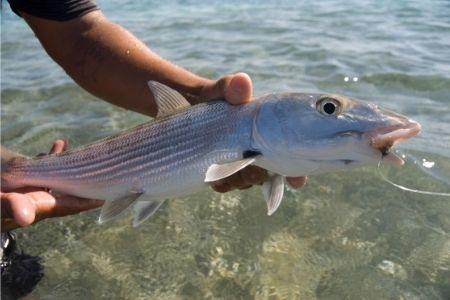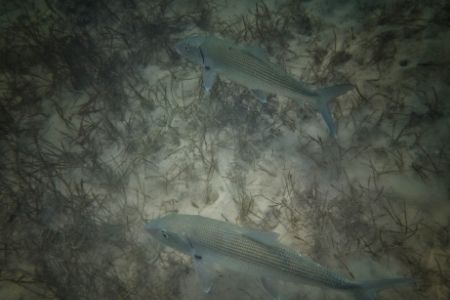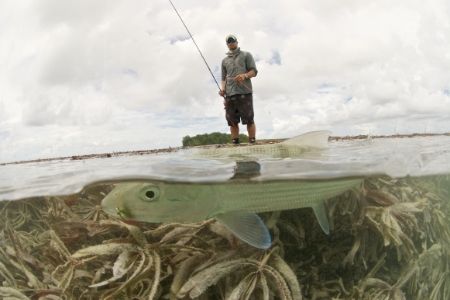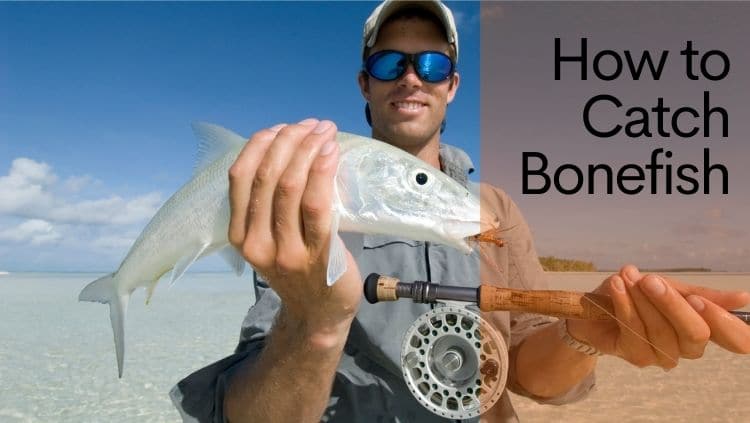Bonefish are a world-renowned species on fly and light tackle. They might not be suitable to eat or grow very large, but man, do they put up a great fight!
While they can be found in shallow coastal waters around the world, bonefish have a reputation as a difficult fish to target. So we’ve put this guide together to help you get started fishing bonefish or pick up some new tricks to try out on your next trip.
Table of Contents
Getting to Know Bonefish

The best piece of advice for any angler is to learn as much about your target species as possible before a trip. This helps you know where to locate the fish and their typical behaviors and gives insight into the gear you need to go after them. We’ll go over a ton of bonefish knowledge in this section.
Identifying Bonefish
Bonefish are notoriously tricky to spot because of their mirror-like silver scales. They reflect the bottom, and the fish can disappear like a ghost thanks to how well they blend in. Their body is overall a silver color but can vary from blue-gray to green-gray.
A small, bony fish, bonefish have downward-facing mouths for feeding along the bottom of the flats they call home. They have a cone-shaped snout that they use to dig into the bottom in search of food. They have a compact, torpedo-shaped body, with vertical stripes that fade as they age into adulthood.
Where can you find bonefish?
There are 9 different species of bonefish found throughout the world. They typically inhabit warm, shallow waters along coasts and spend most of their time in intertidal flats, mangroves, and river mouths.
In the Atlantic, you can find bonefish ranging from Florida, through the Caribbean and South to Central America and Brazil. In the Pacific, they can be seen from San Francisco to Peru and even out in Hawaii. Occasionally, they can be found as far north as New York, New Brunswick, and Northern California.
How big do bonefish get?
Bonefish can grow to weigh as much as twenty pounds with a length of over 31 inches. Most fish will weigh under ten pounds and be much closer to 20 inches. African and Hawaiian species tend to grow larger, while an 8 pound fish in Florida is regarded as a large specimen.
What do bonefish eat?
Bonefish feed on a variety of invertebrates and small fishes. Snails, crabs, worms, and other shellfish are always on the menu, and bonefish dig them out of the bottom with their snout.
Adult bonefish feed on fish more often than younger ones, with Gulf Toadfish being a common favorite. While line-shy and sometimes finicky about baits, they aren’t typically picky eaters and will forage along the bottom for pieces of larger fish as well.
Behaviors to Look Out For

Bonefish can be found solitary or in schools, with larger individuals being found alone more often. Schools are usually made up of similar-sized fish and can vary in size based on location and fish size. Common schools will be duos or run in groups of four to six.
Less commonly, you can find bonefish in schools numbering in the hundreds.
You can sometimes spot bonefish thanks to them sticking their tail out of the water while foraging along the bottom. They love very shallow water, so when they tilt downwards, they can tail similarly to redfish.
Best Ways to Target Bonefish
You can target bonefish in several ways, ranging from fly fishing to typical light tackle and lures, live baits, or cut baits. You’ll typically be wading or poling a small boat and sight casting to the fish.
Best Times to Target Bonefish
The best times of year to catch bonefish are usually between June and November. They tend to feed more readily during the warmer months with higher water temperatures.
While they spawn year-round, November is the peak season for bonefish spawning, and they’re least reproductively active from November until June.
With all that in mind, June through October is when they’re most actively feeding.
Best Tackle for Bonefish
Light tackle and fly gear is best for bonefish. While they’re incredible fighters, heavier gear can overpower them, and you’ll miss out on all the fun.
6 to 12-pound spinning or casting rods and 8 to 9 weight fly rods are ideal. You can size down to a 6 or 7 weight fly setup for more skittish or smaller fish. You want a matching reel with at least 200 yards of workable line on the spool.
Best Line Weights for Bonefish
For fly gear, use line weights that match your tackle with a ten-foot-long tippet. For other tackle, a ten-pound line is an excellent sweet spot. If you prefer braided lines, use a ten to a twenty-foot top shot of monofilament or fluorocarbon to help avoid spooking the bonefish.
Best Baits for Bonefish
When it comes to lures, you want something you can bounce or pull across the bottom since that’s where bonefish typically scoop up prey.
Weighted flies that resemble shrimp or crabs work well. You can also target bonefish with small jigs with paddle tails and even tip the jigs with small pieces of shrimp, conch, or fish if you choose.
Where to Cast
One of the most important things to be able to pull off targeting bonefish is casting. You want to judge where the fish are moving and get your bait out far enough ahead of them not to avoid spooking them and then retrieve it at the right rate to get the bait across their face. This comes through trial and error and a LOT of practice.
You also have to do this quickly since bonefish flash through the water and are always moving. You won’t be able to stare them down and then decide where to cast. You’ll have to spot them and near-instantly begin your cast.
Best Tips for Targeting Bonefish

1. Be as quiet as possible.
Bonefish are notoriously skittish and easy to spook. Making too much noise on the boat, the wrong splash as you wade, or a misplaced cast can all make them run off, never to be seen again.
Don’t use your engine when you’re anywhere near where you plan to fish, pole your boat or just wade instead. Always cast away from the fish so you can naturally bring your lure or bait across its face, and use light lines with clear leaders to avoid line splash.
2. Look for feed marks on flats to help locate bonefish.
Bonefish use their snouts to root through the bottom in search of food. This leaves dark grey marks along the bottom where they were digging.
While bonefish may be hard to spot, the marks they leave on the bottom aren’t. The darker the marks are, the fresher they are. Use these to help you figure out if you’re in the right spot to find bonefish.
3. Look for shadows, not fish.
Even with experience, spotting bonefish can be ridiculously difficult because of the way their scales reflect the bottom. Bonefish can be nearly invisible in the water, and cloudy days only intensify this problem.
What they can’t hide is their shadow on the bottom. Look for those moving shadows on sunnier days when you’re having trouble spotting fish.
4. Chum around your boat with shrimp.
Fishing game fish on the flats usually doesn’t involve any kind of chumming. However, it can still be an effective technique. Instead of poling around and searching for bonefish, you can usually get them to come to you.
Of course, you still need to look for feed marks, find a promising spot, and sight-cast them, but chumming the flats with shrimp is a great way to bring the fish to you. It’s especially effective if you plan on using shrimp as your bait.
Top Picks for Bonefish Fishing Gear
Rods
Orvis Clearwater Fly Rod

Check Price on Amazon
When it comes to an inexpensive bonefish fly rod, it’s hard to beat the Orvis Clearwater 7 weight. It has comfortable handles, great flexibility and is an excellent match for a lightweight fly fishing reel.
St. Croix Mojo Inshore Spinning Rod

Check Price on Amazon
A rod with insane quality and balance, the Mojo Inshore in a light/fast is an excellent bonefish rod. Superb sensitivity, ideal casting distance, and comfortable lightweight make the St. Croix Mojo Inshore a perfect rod for the flats and for tossing small jigs to bonefish.
Reels
Galvan Rush Light Reel

Check Price on Amazon
The Galvan Rush Light Reel is a great bonefish option with all the drag you could use for bonefish in a lightweight and durable package. The simple reel design helps minimize weight, and the oversized arbor gives you an advantage over the fish for quickly picking up any slack line.
Penn Spinfisher VI 3500 Spinning Reel

Check Price on Amazon
The Penn Spinfisher is one of the absolute best saltwater reels you can buy. Great drag power in any size, one of the best sealing systems on the market, and incredibly durable construction make it an excellent choice for any kind of fishing.
The 3500 is an ideal size for bonefish that gives you plenty of line capacity whether you fish monofilament or braided line and has the power you need to tire out any size bonefish.
Baits
For cut baits, shrimp, conch, and glass minnows are great choices. You can also fish live glass minnows or small sardines to entice a strike. Be sure to use small enough pieces or baits for the bonefish to fit it into their mouths.
Shrimp or crab-shaped flies are great lures. Otherwise, fishing a small jig with a paddle tail and maybe a bait tip is your best bet. Artificial scents can help enhance your baits without adding on a natural tip.
Here’s a couple of our top suggestions for lures and jigs for bonefish:
Strike King Saltwater Flats Jig Head

Check Price on Amazon
Crazy Charlie Bonefish Fly Fishing Flies

Check Price on Amazon
Final Thoughts
Bonefish are notorious for being difficult to spot and catch but offer one of the best pound-for-pound fights of any fish in the water. With a bit of knowledge and the right gear, you can go after these prized inshore fish as well.
Hopefully, you’ve picked up a good foundation of knowledge or some extra tips that can help you out after reading this article.

